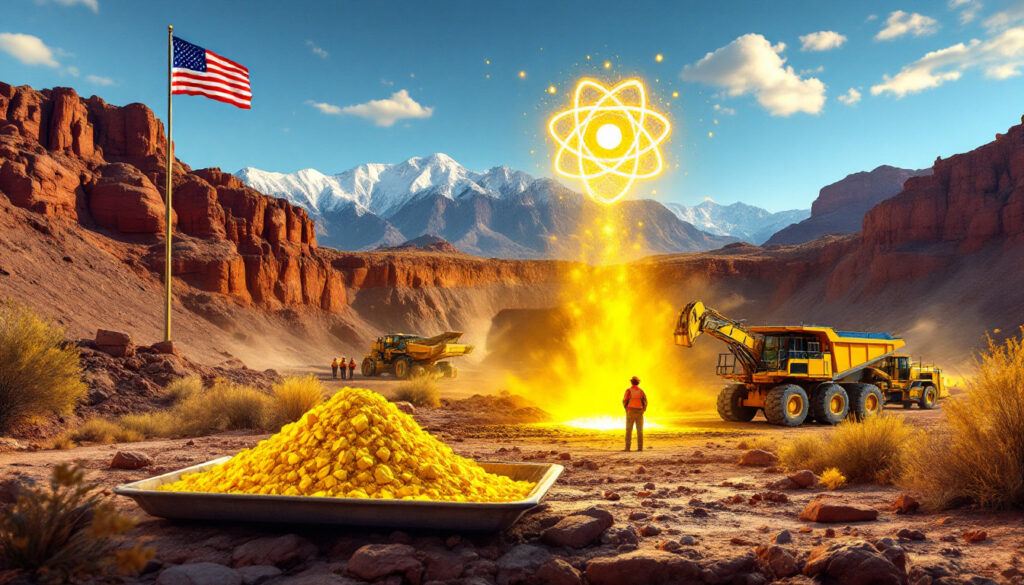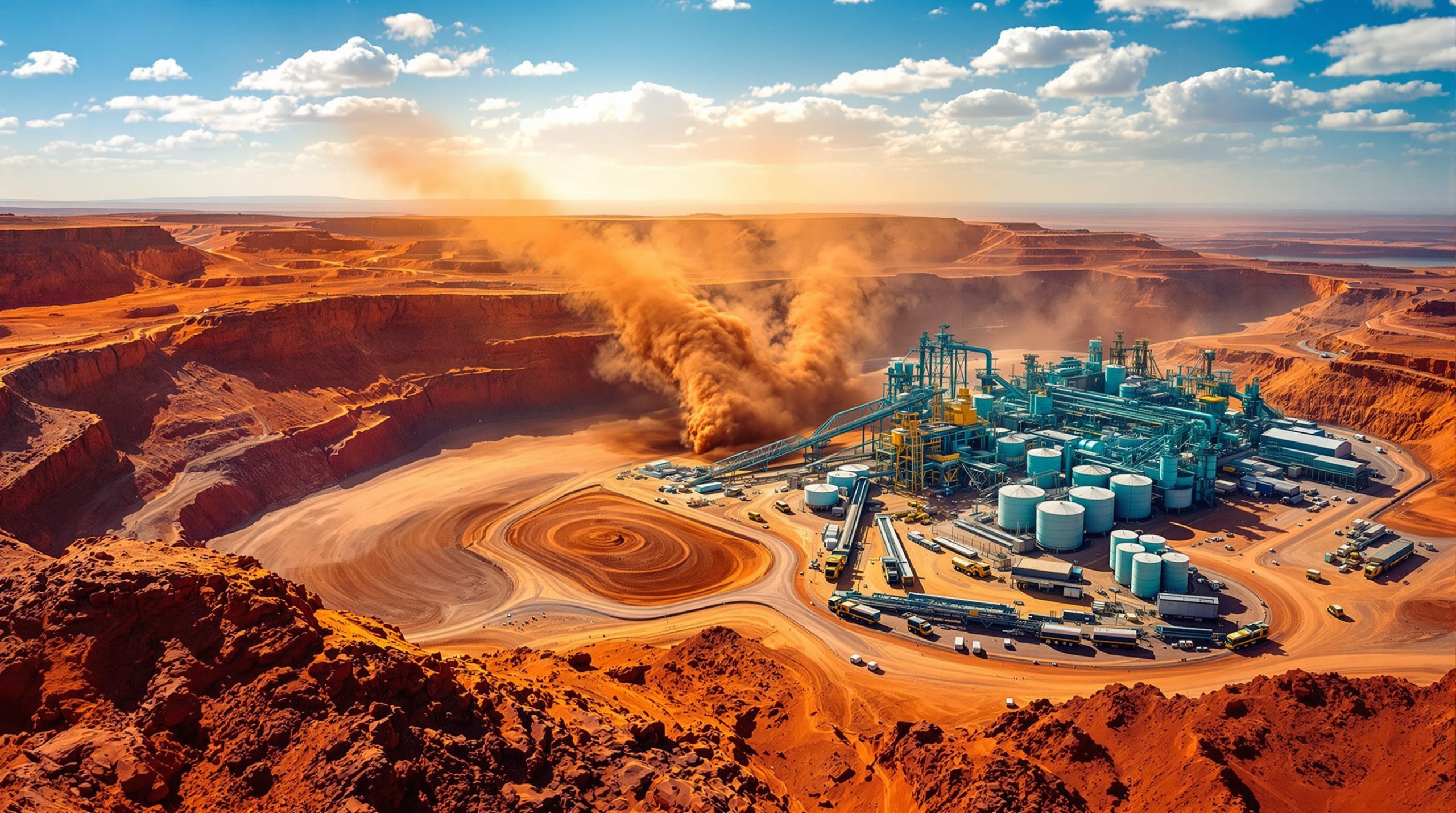US to Fast-Track Utah Uranium Mine Permit: What This Means for Energy Security
In an unprecedented move, the US Interior Department has announced the acceleration of the environmental permitting process for Anfield Energy's Velvet-Wood uranium mine in Utah. This dramatic regulatory shift compresses what typically takes years into just 14 days, signaling a major change in how critical mineral projects are approved. With domestic uranium production currently meeting less than 5% of US demand according to the U.S. Energy Information Administration, this decision represents a significant pivot in America's approach to energy security and critical mineral supply chains.
Why Is the US Expediting Uranium Mining Permits?
The Energy Emergency Declaration
The Interior Department's decision comes as part of a broader strategy to address what Secretary Doug Burgum characterizes as "an alarming energy emergency resulting from previous administration policies." This 14-day environmental review timeline marks a radical departure from the typical multi-year process that mining projects normally face.
"America is facing an alarming energy emergency," stated Burgum in the official announcement. "President Trump and his administration are responding with speed and strength to ensure American energy independence."
This accelerated process leverages specific exemptions within the National Environmental Policy Act (NEPA) for projects deemed critical to national security, highlighting the strategic importance the administration places on domestic uranium production.
National Security Implications
Uranium holds dual strategic importance for both civilian nuclear energy generation and defense applications, including naval propulsion systems and the nuclear deterrent. With Russia supplying approximately 24% of US uranium imports in 2023, the geopolitical implications of foreign dependency have become increasingly concerning to policymakers.
The US currently relies on imports for more than 95% of its uranium needs, creating vulnerability in the supply chain for the fuel that powers approximately 20% of American electricity production. This dependency has been flagged by security experts as a potential risk, particularly as global tensions rise and competition for critical minerals intensifies.
Nuclear security analyst Dr. Rebecca Johnson notes: "The US faces a paradoxical situation where it maintains the world's largest nuclear power fleet while having virtually abandoned domestic uranium production over the past decades."
What Is the Velvet-Wood Project?
Project Specifications and Location
The Velvet-Wood uranium mine is located in San Juan County, Utah, situated on a legacy mining site that previously produced uranium. According to Interior Department documents, the project would create minimal new environmental disruption, with only three acres of new surface disturbance planned.
The project sits atop geological formations favorable for uranium mineralization, with grades estimated at 0.2-0.4% uranium oxide according to Anfield Energy's technical filings. These grades, while modest by global standards, are competitive within the North American context.
The project's relatively contained footprint on an already disturbed site has been cited as a key factor enabling the abbreviated environmental review process. Previous infrastructure from historical operations, including access roads and some processing facilities, remain in place.
Dual-Resource Production Potential
Beyond uranium, the Velvet-Wood project is expected to produce significant quantities of vanadium, a versatile metal increasingly important for energy storage technologies. The global vanadium market is currently valued at approximately $3.5 billion according to the USGS Mineral Commodity Summaries, with growth projected as renewable energy adoption increases.
Vanadium flow batteries (VRFBs) represent one of the most promising grid-scale storage technologies for renewable energy, offering longer duration storage than lithium-ion alternatives. Additionally, vanadium serves as a critical strengthening agent in high-performance steel alloys used in infrastructure, aerospace, and automotive applications.
"The co-production of vanadium significantly enhances the economics of the Velvet-Wood project," explains mining economist Dr. Michael Chen. "This dual-product approach provides a hedge against uranium market volatility while supplying two critical minerals from a single operation."
How Will This Impact Domestic Uranium Production?
Anfield Energy's Production Pipeline
Anfield Energy's uranium strategy extends beyond the Velvet-Wood mine to include the Shootaring Canyon uranium mill, also located in Utah. This processing facility has a licensed capacity of 750,000 pounds of uranium concentrate (U3O8) annually, representing a significant portion of potential near-term domestic production capacity.
The Shootaring Canyon mill would convert uranium ore from Velvet-Wood into yellowcake, the concentrated powder form of uranium that serves as the precursor to nuclear fuel. This vertical integration represents one of the few near-term paths to meaningful domestic uranium production.
Current U.S. production stands at just 0.2 million pounds in 2023, compared to approximately 40 million pounds consumed by American nuclear plants, according to EIA data. The addition of Velvet-Wood's production could mark a meaningful step toward reducing this substantial gap.
Market Implications for US Uranium
The global uranium market has experienced significant price increases over the past two years, with spot prices rising from approximately $30 per pound in 2022 to $65 per pound in early 2025, according to industry data from Cameco. These price levels incentivize the development of domestic resources that were previously uneconomical.
Industry analysts suggest that Velvet-Wood could be the first of several uranium projects to receive expedited treatment, potentially signaling a renaissance for an industry that has struggled for decades against cheaper international competition, particularly from Kazakhstan, which currently produces approximately 40% of global uranium supply.
- Uranium spot prices have more than doubled since 2022
- Current price levels support the economic case for domestic production
- The Velvet-Wood project could produce approximately 500,000 pounds annually at full operation
- US nuclear plants require approximately 45 million pounds of uranium annually
What Are the Environmental Considerations?
Abbreviated Environmental Review Process
The 14-day environmental review timeline represents an extraordinary compression of standard practice. Typically, uranium mining projects undergo extensive studies requiring years to complete, assessing:
- Groundwater contamination potential
- Radiation exposure risks
- Soil contamination concerns
- Wildlife and habitat impacts
- Cultural resource preservation
Environmental organizations have expressed alarm at the abbreviated process. "Fourteen days is insufficient to adequately assess the potential long-term impacts of a uranium mining operation," states Sierra Club spokesperson Jamie Rodriguez. "These projects have centuries-long potential contamination timelines that demand thorough analysis."
The southwestern United States currently contains more than 1,200 abandoned uranium mines according to EPA data, many of which continue to pose environmental challenges decades after operations ceased.
Prior Mining Site Advantages
The Interior Department has emphasized that Velvet-Wood's location at a previously mined site substantially reduces environmental concerns. Historical mining sites already have existing disturbance patterns, potentially minimizing additional impacts.
However, the legacy of uranium mining in the American Southwest includes significant contamination issues. The 1979 Church Rock spill in neighboring New Mexico released 94 million gallons of radioactive waste into the environment in what remains one of America's largest radioactive incidents.
The Navajo Nation, which has experienced disproportionate impacts from uranium mining, continues to deal with contamination affecting an estimated 600,000 people according to CDC reports. Navajo Nation President Buu Nygren has consistently expressed concerns about uranium development, noting that "past uranium mining left a toxic legacy on Navajo lands that we're still addressing today."
"The distinction between a new greenfield project and restarting operations at a brownfield site is significant from both an environmental and regulatory perspective," explains environmental engineer Dr. Sarah Williams. "While the footprint may be smaller, legacy contamination issues often require careful assessment and remediation planning."
What Does This Mean for the US Energy Strategy?
Shift in Regulatory Approach
The expedited permitting process signals a fundamental shift in how the federal government approaches energy resource development. This regulatory streamlining aligns with broader efforts to reduce barriers to domestic production across multiple sectors.
The administration has identified approximately 50 critical minerals considered essential for economic and national security, with uranium ranking among the highest priority. The acceleration of permitting for these resources represents a significant departure from previous approaches that prioritized extended environmental review.
This shift has been welcomed by industry groups but criticized by environmental organizations concerned about potential long-term impacts. The legal framework for this abbreviated review process will likely face judicial scrutiny.
Nuclear Energy's Role in Energy Security
The administration's support for uranium mining reflects a renewed emphasis on nuclear energy within the broader energy security strategy. America's 96 operating nuclear reactors provide approximately 20% of total electricity generation and more than 50% of carbon-free electricity production.
The Department of Energy has allocated $6 billion for advanced nuclear R&D in 2024, with particular focus on next-generation technologies like Small Modular Reactors (SMRs). These advanced designs require High-Assay Low-Enriched Uranium (HALEU) with enrichment levels between 5-20%, compared to the 3-5% used in conventional reactors.
"Nuclear is indispensable for grid reliability and deep decarbonization," states Nuclear Energy Institute CEO Maria Korsnick. "Securing the fuel supply chain is a critical component of maintaining and expanding this vital energy source."
The Russian state nuclear corporation Rosatom currently supplies approximately 20% of global enriched uranium and dominates the HALEU market, creating potential supply vulnerabilities for next-generation nuclear technologies. Additionally, the recent US uranium import ban on Russian materials further emphasizes the need for domestic production.
How Are Investors Responding?
Market Reaction to Expedited Permitting
Anfield Energy has expressed satisfaction with the Interior Department's announcement, noting that the expedited process brings "increased investor attention to the sector" while boosting the company's production prospects. The company's stock price increased by 17% following the announcement.
The broader uranium mining sector has experienced significant volatility in recent years, with the Global X Uranium ETF (URA) gaining over 140% since 2022, driven by supply constraints, policy shifts, and growing recognition of nuclear energy's role in addressing climate change.
Institutional investors have increasingly recognized uranium's potential as both an energy transition play and a geopolitical hedge. According to financial analytics firm S&P Global, investment flows into uranium-focused funds have increased by approximately 200% since 2021.
Investment Landscape for Uranium Projects
The fast-tracking of the Velvet-Wood project signals potentially improved prospects for uranium mining investments in the United States. Companies with permitted or near-permitted projects could see increased investor interest as the regulatory environment becomes more favorable.
Investment strategist Marcus Williams of Resource Capital Partners explains: "The policy shift creates a more predictable pathway to production for U.S. uranium projects. The combination of streamlined permitting, strong uranium prices, and bipartisan support for nuclear energy creates a potentially favorable investment environment that we haven't seen in decades."
Factors influencing investor sentiment include:
- Uranium spot prices above $65/lb – well above the production costs of most U.S. projects
- Increased nuclear power deployments in China, India, and the Middle East
- Growing recognition of nuclear's role in climate solutions
- Geopolitical concerns about Russian and Kazakh supply dominance
Experts recommend examining various uranium investment strategies to capitalize on these market shifts.
What Precedent Does This Set?
Future Fast-Track Candidates
The decision to expedite the Velvet-Wood project may establish a precedent for other critical mineral and energy projects. Industry observers are closely monitoring which other projects might receive similar treatment.
Potential candidates for accelerated review include:
- Rare earth element projects in Wyoming and Texas
- Lithium mining operations in Nevada's Clayton Valley
- Additional uranium projects in Wyoming's Powder River Basin
- Copper and nickel projects in Minnesota and Arizona
The administration has indicated that projects with minimal new surface disturbance, particularly those on previously mined sites, will receive highest priority for expedited treatment. This approach aligns with the recent critical minerals order that aims to reduce foreign dependence on strategically important resources.
Legal and Regulatory Implications
The abbreviated environmental review process could face significant legal challenges from environmental groups, affected communities, and tribal nations. Previous attempts to streamline permitting for extractive industries have often encountered judicial scrutiny.
The legal foundation for the 14-day review rests on specific provisions within NEPA allowing for expedited treatment of projects deemed critical to national security. However, these provisions have rarely been applied so aggressively to mineral extraction projects.
Environmental attorney Rebecca Martinez notes: "The courts have generally required thorough environmental review, particularly for projects with potential long-term impacts like uranium mining. The abbreviated timeline will likely face legal challenges testing whether it meets the 'hard look' standard established in previous cases."
The outcome of any litigation could significantly impact the implementation of similar expedited processes for future projects and establish important precedent for critical mineral development, as reported by Seeking Alpha.
FAQ: US Uranium Mining and Energy Security
How much uranium does the US currently produce domestically?
The United States currently produces less than 5% of the uranium it consumes, with domestic production accounting for approximately 0.2 million pounds in 2023 according to the Energy Information Administration. The majority of uranium used in US nuclear power plants comes from Canada, Australia, Kazakhstan, and Russia, which collectively supply over 90% of US uranium.
What is the significance of the 14-day review timeline?
The 14-day environmental review timeline represents an extraordinary acceleration compared to standard practices, which typically require 3-7 years of study, public comment periods, and regulatory review. This compressed timeline reflects the administration's prioritization of energy security concerns over traditional environmental review processes, leveraging national security provisions within existing environmental laws.
How does uranium mining affect local communities?
Uranium mining can provide economic benefits through job creation and tax revenue for local communities, but also raises concerns about potential environmental impacts. Historical uranium mining in the American Southwest has left a legacy of contamination affecting many communities, particularly on tribal lands. The CDC has documented health impacts including increased cancer rates in some areas with prolonged uranium mining exposure. Modern mining techniques incorporate significantly improved environmental controls, though long-term monitoring remains essential, according to Energy News.
What role does nuclear power play in US energy strategy?
Nuclear power provides approximately 20% of US electricity generation and over 50% of carbon-free electricity. With 96 operating reactors, the US maintains the world's largest nuclear fleet. The current administration views nuclear energy as a critical component of both energy security and climate strategy, with significant investments in next-generation technologies including small modular reactors and advanced fuel cycles. Securing domestic uranium supplies supports both existing reactors and future nuclear deployments.
Want to Capitalise on the Next Major Mineral Discovery?
Stay ahead of the market with real-time alerts on significant ASX mineral discoveries through Discovery Alert's proprietary Discovery IQ model, which instantly transforms complex data into actionable investment insights. Explore why historic discoveries can generate substantial returns by visiting Discovery Alert's dedicated discoveries page and begin your 30-day free trial today.




